Toward Current Matching in Tandem Dye-Sensitized Solar Cells
Abstract
1. Introduction
2. Experimental
3. Results and Discussion
4. Conclusions
Author Contributions
Funding
Acknowledgments
Conflicts of Interest
References
- O’Regan, B.; Grätzel, M.; Gr, M. A low-cost, high-efficiency solar cell based on dye-sensitized colloidal TiO2 films. Nature 1991, 353, 737–740. [Google Scholar] [CrossRef]
- Mathew, S.; Yella, A.; Gao, P.; Humphry-Baker, R.; Curchod, B.F.E.; Astani, N.A.; Tavernelli, I.; Rothlisberger, U.; Nazeeruddin, K.; Grätzel, M. Dye-sensitized solar cells with 13% efficiency achieved through the molecular engineering of porphyrin sensitizers. Nat. Chem. 2014, 6, 242–247. [Google Scholar] [CrossRef]
- Yamaguchi, T.; Uchida, Y.; Agatsuma, S.; Arakawa, H. Series-connected tandem dye-sensitized solar cell for improving efficiency to more than 10%. Sol. Energy Mater. Sol. Cells 2009, 93, 733–736. [Google Scholar] [CrossRef]
- Murayama, M.; Mori, T. Dye-sensitized solar cell using novel tandem cell structure. J. Phys. D Appl. Phys. 2007, 40, 1664–1668. [Google Scholar] [CrossRef]
- Hagfeldt, A.; Boschloo, G.; Sun, L.; Kloo, L.; Pettersson, H. Dye-Sensitized Solar Cells. Chem. Rev. 2010, 110, 6595–6663. [Google Scholar] [CrossRef]
- He, J.; Lindström, H.; Hagfeldt, A.; Lindquist, S.-E. Dye-sensitized nanostructured tandem cell-first demonstrated cell with a dye-sensitized photocathode. Sol. Energy Mater. Sol. Cells 2000, 62, 265–273. [Google Scholar] [CrossRef]
- Bruder, I.; Karlsson, M.; Eickemeyer, F.; Hwang, J.; Erk, P.; Hagfeldt, A.; Weis, J.; Pschirer, N. Efficient organic tandem cell combining a solid state dye-sensitized and a vacuum deposited bulk heterojunction solar cell. Sol. Energy Mater. Sol. Cells 2009, 93, 1896–1899. [Google Scholar] [CrossRef]
- Zhang, S.; Yang, X.; Numata, Y.; Han, L. Highly efficient dye-sensitized solar cells: Progress and future challenges. Energy Environ. Sci. 2013, 6, 1443. [Google Scholar] [CrossRef]
- Nattestad, A.; Mozer, A.J.; Fischer, M.K.R.; Cheng, Y.-B.; Mishra, A.; Bäuerle, P.; Bach, U. Highly efficient photocathodes for dye-sensitized tandem solar cells. Nat. Mater. 2009, 9, 31–35. [Google Scholar] [CrossRef]
- Kashif, M.K.; Nippe, M.; Duffy, N.W.; Forsyth, C.M.; Chang, C.J.; Long, J.R.; Spiccia, L.; Bach, U. Stable Dye-Sensitized Solar Cell Electrolytes Based on Cobalt(II)/(III) Complexes of a Hexadentate Pyridyl Ligand. Angew. Chem. Int. Ed. 2013, 52, 5527–5531. [Google Scholar] [CrossRef]
- Ji, Z.; Natu, G.; Huang, Z.; Wu, Y. Linker effect in organic donor–acceptor dyes for p-type NiO dye sensitized solar cells. Energy Environ. Sci. 2011, 4, 2818. [Google Scholar] [CrossRef]
- Bonomo, M.; Saccone, D.; Magistris, C.; Di Carlo, A.; Barolo, C.; Dini, D. Effect of Alkyl Chain Length on the Sensitizing Action of Substituted Non-Symmetric Squaraines for p-Type Dye-Sensitized Solar Cells. ChemElectroChem 2017, 4, 2385–2397. [Google Scholar] [CrossRef]
- Wood, C.; Summers, G.H.; Clark, C.A.; Kaeffer, N.; Braeutigam, M.; Carbone, L.R.; D’Amario, L.; Fan, K.; Farré, Y.; Narbey, S.; et al. A comprehensive comparison of dye-sensitized NiO photocathodes for solar energy conversion. Phys. Chem. Chem. Phys. 2016, 18, 10727–10738. [Google Scholar] [CrossRef]
- Odobel, F.; Pellegrin, Y. Recent Advances in the Sensitization of Wide-Band-Gap Nanostructured p-Type Semiconductors. Photovoltaic and Photocatalytic Applications. J. Phys. Chem. Lett. 2013, 4, 2551–2564. [Google Scholar] [CrossRef]
- Shalom, M.; Hod, I.; Tachan, Z.; Buhbut, S.; Tirosh, S.; Zaban, A. Quantum dot based anode and cathode for high voltage tandem photo -electrochemical solar cell. Energy Environ. Sci. 2011, 4, 1874. [Google Scholar] [CrossRef]
- Barceló, I.; Guillén, E.; Lana-Villarreal, T.; Gómez, R. Preparation and Characterization of Nickel Oxide Photocathodes Sensitized with Colloidal Cadmium Selenide Quantum Dots. J. Phys. Chem. C 2013, 117, 22509–22517. [Google Scholar] [CrossRef]
- Bonomo, M.; Di Girolamo, D.; Piccinni, M.; Dowling, D.; Dini, D. Electrochemically Deposited NiO Films as a Blocking Layer in p-Type Dye-Sensitized Solar Cells with an Impressive 45% Fill Factor. Nanomaterials 2020, 10, 167. [Google Scholar] [CrossRef] [PubMed]
- Brisse, R.; Faddoul, R.; Bourgeteau, T.; Tondelier, D.; Leroy, J.; Campidelli, S.; Berthelot, T.; Geffroy, B.; Jousselme, B. Inkjet Printing NiO-Based p-Type Dye-Sensitized Solar Cells. ACS Appl. Mater. Interfaces 2017, 9, 2369–2377. [Google Scholar] [CrossRef]
- Nattestad, A.; Zhang, X.; Bach, U.; Cheng, Y.-B. Dye-sensitized CuAlO2 photocathodes for tandem solar cell applications. J. Photon- Energy 2011, 1, 11103. [Google Scholar] [CrossRef]
- Nakasa, A.; Usami, H.; Sumikura, S.; Hasegawa, S.; Koyama, T.; Suzuki, E. A High Voltage Dye-sensitized Solar Cell using a Nanoporous NiO Photocathode. Chem. Lett. 2005, 34, 500–501. [Google Scholar] [CrossRef]
- Gibson, E.A.; Smeigh, A.; Le Pleux, L.; Fortage, J.; Boschloo, G.; Blart, E.; Pellegrin, Y.; Odobel, F.; Hagfeldt, A.; Hammarström, L. A p-Type NiO-Based Dye-Sensitized Solar Cell with an Open-Circuit Voltage of 0.35 V. Angew. Chem. Int. Ed. 2009, 48, 4402–4405. [Google Scholar] [CrossRef] [PubMed]
- Qian, J.; Jiang, K.; Huang, J.; Liu, Q.; Yang, L.; Song, Y. A Selenium-Based Cathode for a High-Voltage Tandem Photoelectrochemical Solar Cell. Angew. Chem. Int. Ed. 2012, 51, 10351–10354. [Google Scholar] [CrossRef] [PubMed]
- Ho, P.; Thogiti, S.; Bao, L.Q.; Cheruku, R.; Ahn, K.-S.; Kim, J.H. Enhanced efficiency via blocking layers at photocathode interfaces in cobalt-mediated tandem dye-sensitized solar cells. Sol. Energy 2018, 161, 9–16. [Google Scholar] [CrossRef]
- Yu, M.; Natu, G.; Ji, Z.; Wu, Y. p-Type Dye-Sensitized Solar Cells Based on Delafossite CuGaO2 Nanoplates with Saturation Photovoltages Exceeding 460 mV. J. Phys. Chem. Lett. 2012, 3, 1074–1078. [Google Scholar] [CrossRef] [PubMed]
- Xiong, D.; Xu, Z.; Zeng, X.; Zhang, W.; Chen, W.; Xu, X.; Wang, M.-K.; Cheng, Y.-B. Hydrothermal synthesis of ultrasmall CuCrO2 nanocrystal alternatives to NiO nanoparticles in efficient p-type dye-sensitized solar cells. J. Mater. Chem. 2012, 22, 24760. [Google Scholar] [CrossRef]
- Kim, J.Y.; Kim, S.H.; Lee, H.-H.; Lee, K.; Ma, W.; Gong, X.; Heeger, A.J. New Architecture for High-Efficiency Polymer Photovoltaic Cells Using Solution-Based Titanium Oxide as an Optical Spacer. Adv. Mater. 2006, 18, 572–576. [Google Scholar] [CrossRef]
- Nithyanandam, K.; Pitchumani, R. Analysis and design of dye-sensitized solar cell. Sol. Energy 2012, 86, 351–368. [Google Scholar] [CrossRef]
- Koide, N.; Islam, A.; Chiba, Y.; Han, L. Improvement of efficiency of dye-sensitized solar cells based on analysis of equivalent circuit. J. Photochem. Photobiol. A: Chem. 2006, 182, 296–305. [Google Scholar] [CrossRef]
- Huang, Z.; Natu, G.; Ji, Z.; He, M.; Yu, M.; Wu, Y. Probing the Low Fill Factor of NiO p-Type Dye-Sensitized Solar Cells. J. Phys. Chem. C 2012, 116, 26239–26246. [Google Scholar] [CrossRef]
- Zhang, Y.-D.; Huang, X.-M.; Li, D.-M.; Luo, Y.-H.; Meng, Q.-B. How to improve the performance of dye-sensitized solar cell modules by light collection. Sol. Energy Mater. Sol. Cells 2012, 98, 417–423. [Google Scholar] [CrossRef]
- Hanmin, T.; Xiaobo, Z.; Shikui, Y.; Xiangyan, W.; Zhipeng, T.; Bin, L.; Ying, W.; Tao, Y.; Zhigang, Z. An improved method to estimate the equivalent circuit parameters in DSSCs. Sol. Energy 2009, 83, 715–720. [Google Scholar] [CrossRef]
- Han, L.; Koide, N.; Chiba, Y.; Mitate, T. Modeling of an equivalent circuit for dye-sensitized solar cells. Appl. Phys. Lett. 2004, 84, 2433–2435. [Google Scholar] [CrossRef]
- Huang, Z.; Natu, G.; Ji, Z.; Hasin, P.; Wu, Y. p-Type Dye-Sensitized NiO Solar Cells: A Study by Electrochemical Impedance Spectroscopy. J. Phys. Chem. C 2011, 115, 25109–25114. [Google Scholar] [CrossRef]
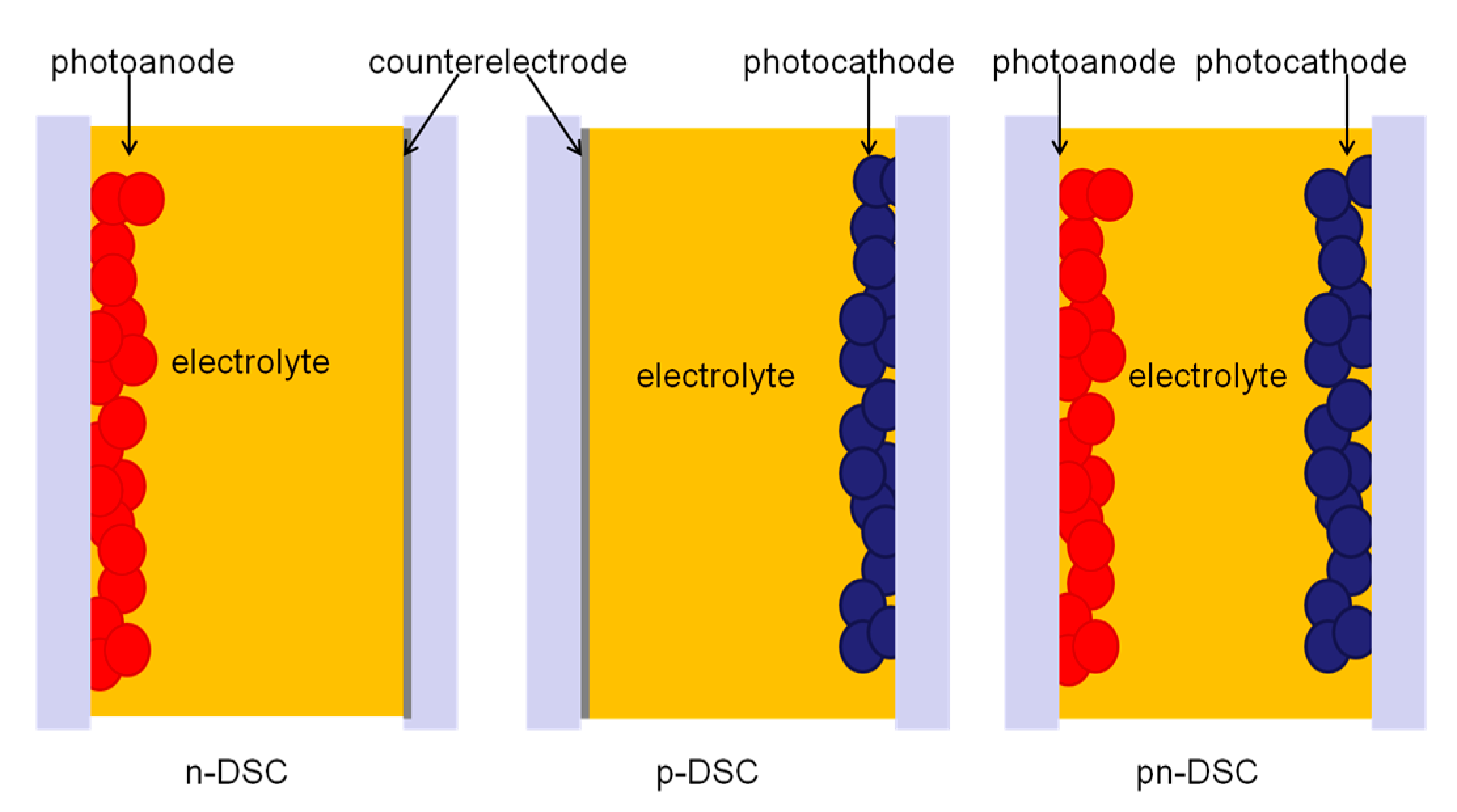
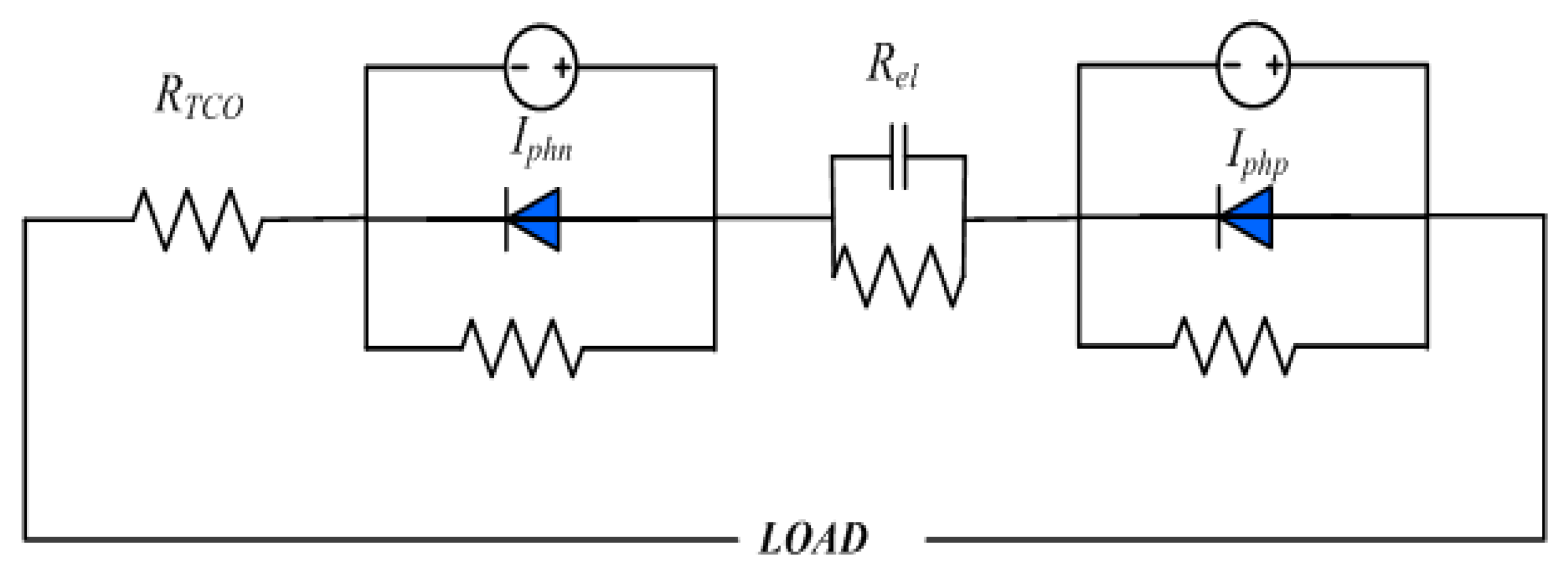
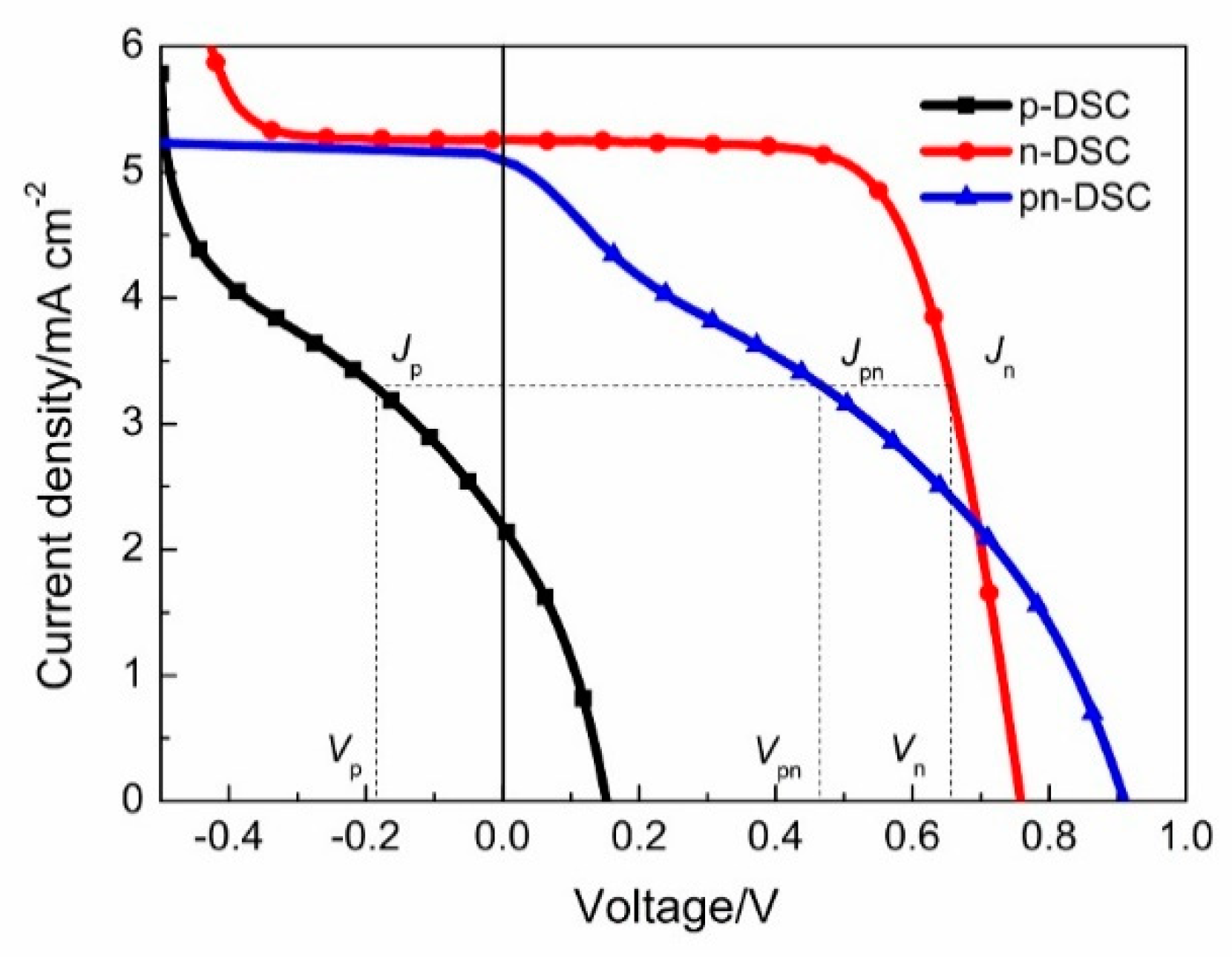
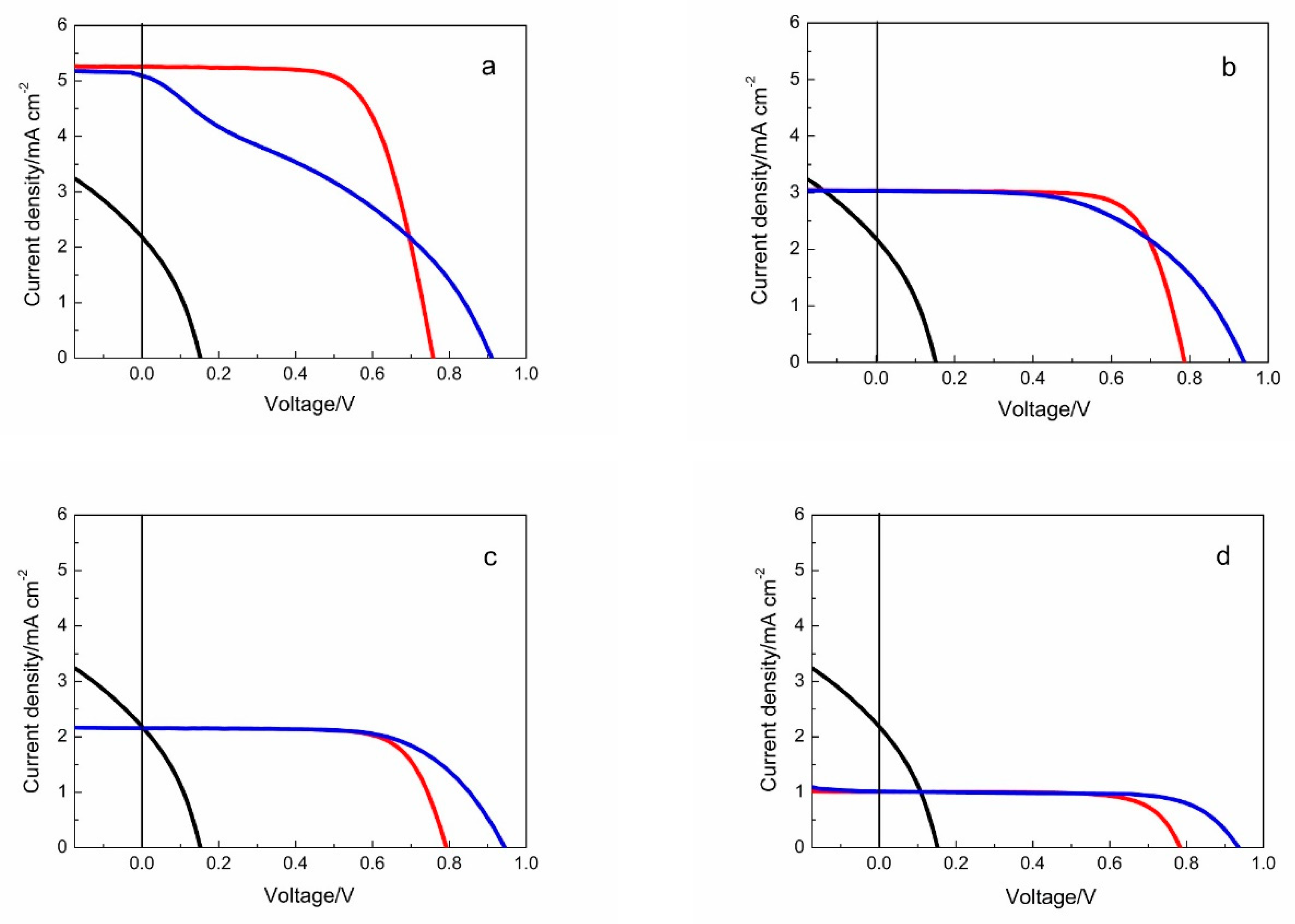
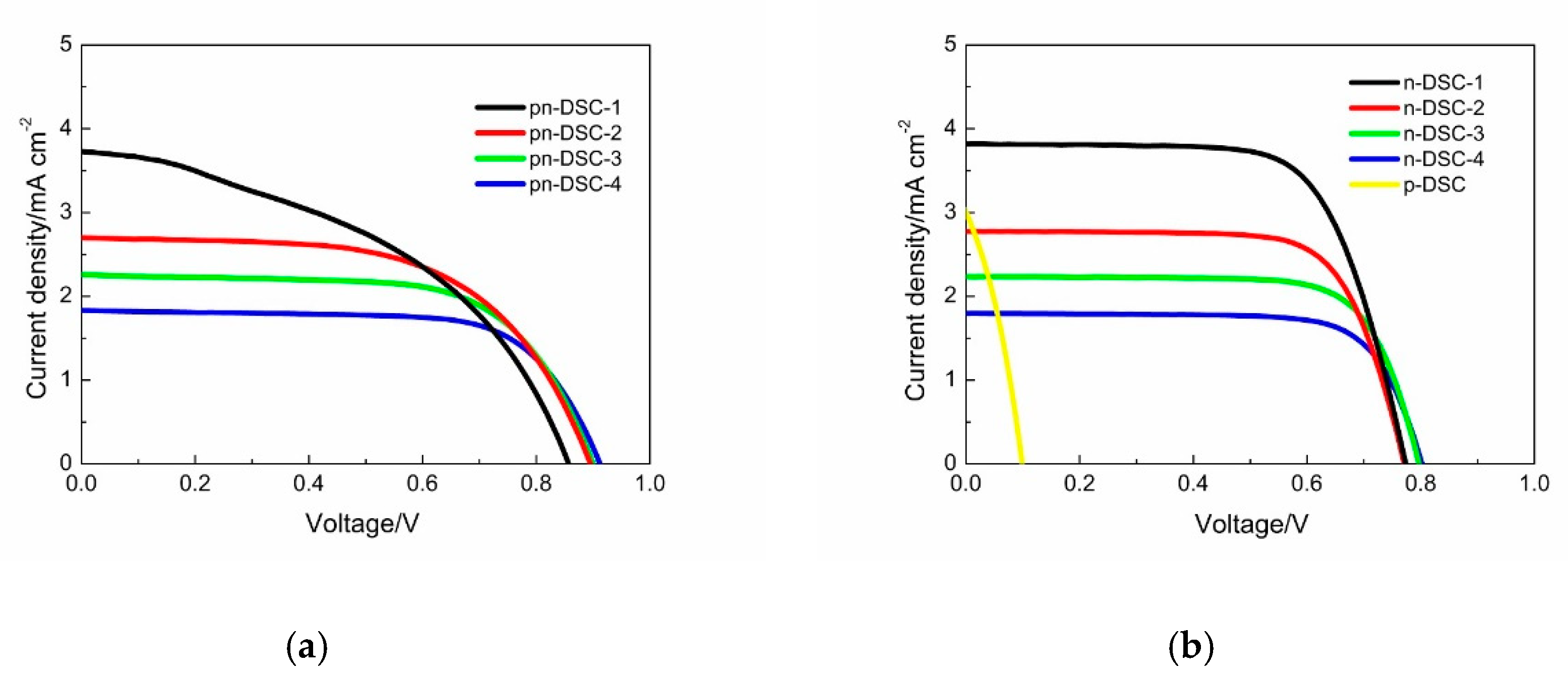
| Condition | Jsc (mA cm−2) | Voc (V) | FF (%) | PCE (%) | Vmax (V) | |
|---|---|---|---|---|---|---|
| PSC | 2.19 | 0.15 | 34.6 | 0.12 | 0.09 | |
| 1 | n-DSC | 5.26 | 0.76 | 67.2 | 2.68 | 0.56 |
| pn-DSC | 5.10 | 0.91 | 35.2 | 1.64 | 0.58 | |
| 2 | n-DSC | 3.04 | 0.79 | 72.3 | 1.73 | 0.62 |
| pn-DSC | 3.04 | 0.94 | 54.5 | 1.56 | 0.63 | |
| 3 | n-DSC | 2.16 | 0.79 | 72.3 | 1.23 | 0.63 |
| pn-DSC | 2.15 | 0.94 | 64.0 | 1.29 | 0.68 | |
| 4 | n-DSC | 1.01 | 0.78 | 73.0 | 0.57 | 0.64 |
| pn-DSC | 1.01 | 0.93 | 72.1 | 0.67 | 0.74 |
| Jsc (mA cm2) | Voc (mV) | FF (%) | PCE (%) | |
|---|---|---|---|---|
| PSC | 3.00 | 98 | 33.5 | 0.10 |
| n-DSC-1 | 3.82 | 773 | 68.8 | 2.03 |
| pn-DSC-1 | 3.73 | 855 | 44.5 | 1.42 |
| n-DSC-2 | 2.78 | 771 | 72.0 | 1.54 |
| pn-DSC-2 | 2.70 | 895 | 59.0 | 1.43 |
| n-DSC-3 | 2.24 | 797 | 73.5 | 1.31 |
| pn-DSC-3 | 2.27 | 899 | 65.3 | 1.33 |
| n-DSC-4 | 1.80 | 802 | 73.8 | 1.06 |
| pn-DSC-4 | 1.84 | 912 | 68.9 | 1.15 |
© 2020 by the authors. Licensee MDPI, Basel, Switzerland. This article is an open access article distributed under the terms and conditions of the Creative Commons Attribution (CC BY) license (http://creativecommons.org/licenses/by/4.0/).
Share and Cite
Wei, J.; Shao, Z.; Pan, B.; Chen, S.; Hu, L.; Dai, S. Toward Current Matching in Tandem Dye-Sensitized Solar Cells. Materials 2020, 13, 2936. https://doi.org/10.3390/ma13132936
Wei J, Shao Z, Pan B, Chen S, Hu L, Dai S. Toward Current Matching in Tandem Dye-Sensitized Solar Cells. Materials. 2020; 13(13):2936. https://doi.org/10.3390/ma13132936
Chicago/Turabian StyleWei, Junfeng, Zhipeng Shao, Bin Pan, Shuanghong Chen, Linhua Hu, and Songyuan Dai. 2020. "Toward Current Matching in Tandem Dye-Sensitized Solar Cells" Materials 13, no. 13: 2936. https://doi.org/10.3390/ma13132936
APA StyleWei, J., Shao, Z., Pan, B., Chen, S., Hu, L., & Dai, S. (2020). Toward Current Matching in Tandem Dye-Sensitized Solar Cells. Materials, 13(13), 2936. https://doi.org/10.3390/ma13132936




